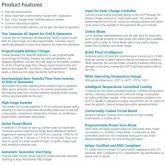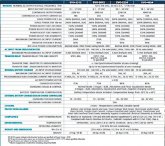Steve_S
Offgrid Cabineer, N.E. Ontario, Canada
Hello everyone,
I am a recent member to this Forum and have noticed very little knowledge about a certain product line of Inverter/Chargers, namely Samlex who has been in the business quite a long time. They produce quality equipment and can actually save a LOT of hassle & problems encountered by many.
Note: I HAVE NO ASSOCIATION OR AFFILIATION WITH SAMLEX, just a happy customer.
Some Highlights on the various models:
Models Available EVO-2212 2200 Watts 12 VDC, EVO-3012 3000 Watts 12 VDC, EVO-2224 2200 Watts 24 VDC, EVO-4024 4000 Watts 24 VDC, EVOTM models also available in 230V.
* Pure Sine Inverter/Chargers: (2 AC Input) https://samlexamerica.com/products/ProductsList.aspx?cid=S51
* The Charge Controllers: (can use others) https://samlexamerica.com/products/Category.aspx?cid=M6
* Samlex Manual (big, covers all models): Samlex Manual PDF (Covers all models) https://samlexamerica.com/documents/manuals/11025-EVO-2212-3012-2224-4024-0819_Hrez.pdf
---


---

---

---

---
I am a recent member to this Forum and have noticed very little knowledge about a certain product line of Inverter/Chargers, namely Samlex who has been in the business quite a long time. They produce quality equipment and can actually save a LOT of hassle & problems encountered by many.
Note: I HAVE NO ASSOCIATION OR AFFILIATION WITH SAMLEX, just a happy customer.
Some Highlights on the various models:
Models Available EVO-2212 2200 Watts 12 VDC, EVO-3012 3000 Watts 12 VDC, EVO-2224 2200 Watts 24 VDC, EVO-4024 4000 Watts 24 VDC, EVOTM models also available in 230V.
* Pure Sine Inverter/Chargers: (2 AC Input) https://samlexamerica.com/products/ProductsList.aspx?cid=S51
* The Charge Controllers: (can use others) https://samlexamerica.com/products/Category.aspx?cid=M6
* Samlex Manual (big, covers all models): Samlex Manual PDF (Covers all models) https://samlexamerica.com/documents/manuals/11025-EVO-2212-3012-2224-4024-0819_Hrez.pdf
Soft Start: The inverter design incorporates “Soft Start” feature with the following advantages and protections:
- When the unit powers up, it starts in Inverting Mode first. The output voltage ramps up gradually from around 48 VAC to 120 VAC in around 200 ms. This reduces otherwise very high starting inrush current drawn by AC loads like Switched Mode Power Supplies (SMPS) and motor driven loads like fans, pumps, compressors etc. This will result in lower motor inrush current (which typically can be up to 650% of the full load current of the motor), which means lesser mechanical stresses, wear and tear and increased lifetime of the motor, coupling and fan. Additionally, the impact on the load side components is greatly reduced, meaning less likelihood of causing problematic voltage drops during starting.
- When the unit powers up, it starts in Inverting Mode first. The output voltage ramps up gradually from around 48 VAC to 120 VAC in around 200 ms. This reduces otherwise very high starting inrush current drawn by AC loads like Switched Mode Power Supplies (SMPS) and motor driven loads like fans, pumps, compressors etc. This will result in lower motor inrush current (which typically can be up to 650% of the full load current of the motor), which means lesser mechanical stresses, wear and tear and increased lifetime of the motor, coupling and fan. Additionally, the impact on the load side components is greatly reduced, meaning less likelihood of causing problematic voltage drops during starting.
3.16 INSTALLING CONTROL INPUT WIRING FROM LITHIUM BATTERY MANAGEMENT SYSTEM (BMS) TO ENABLE / DISABLE CHARGING OR INVERTING Refer to Section 5.11.2 regarding “Stop Charging” or “Stop Inverting” protections for Lithium Ion Batteries when parameter “BATTERY TYPE” is programmed for Option 2 - “1=Lithium” (See programming details at Section 4.4.2.22.2 in the EVO-RC Manual attached at Appendix A)
The Battery Charger Section of EVO is designed to charge 3 types of batteries - Lead Acid / Nickel Zinc (Ni-Zn) / Lithium Ion. Lead Acid and Nickel Zinc (Ni-Zn) battery charging voltages are required to be compensated based on the temperature of the battery cells. Hence, Battery Temperature Sensor Model EVO-BCTS is required to be connected to the RJ-45 Jack (6, Fig 2.1) as explained at Section 3.15.
Charging voltages of Lithium Ion Battery are not affected by temperature and hence, Battery Temperature Sensor Model EVO-BCTS is NOT required to be used when Lithium Ion batteries are used. The RJ-45 Jack (6, Fig 2.1) can be used to feed control signals from certain Lithium Ion Battery Management Systems (BMS) that may have capability of enabling / disabling “Stop Charging” or “Stop Inverting” control signals for inverter chargers. This control signal is normally generated by the BMS by switching ON (enabling) or switching OFF (disabling) potential free, Drain (+) and Source (-) terminals of mini Opto Isolated Mosfet Switch [Solid-State Relay (SSR)]. Connect the control signal output from the BMS to RJ-45 Jack (6, Fig 2.1) as follows:
• BMS control signal terminal marked “+”: o Connect to any of Pins 1/2/3/4 (Refer to Fig 3.13 for pinout of RJ-45 Jack. Pins 1 to 4 are internally shorted) • BMS control signal terminal marked “-”: o Connect to any of Pins 5/6/7/8 (Refer to Fig 3.13 for pinout of RJ-45 Jack. Pins 5 to 8 internally shorted)
The Battery Charger Section of EVO is designed to charge 3 types of batteries - Lead Acid / Nickel Zinc (Ni-Zn) / Lithium Ion. Lead Acid and Nickel Zinc (Ni-Zn) battery charging voltages are required to be compensated based on the temperature of the battery cells. Hence, Battery Temperature Sensor Model EVO-BCTS is required to be connected to the RJ-45 Jack (6, Fig 2.1) as explained at Section 3.15.
Charging voltages of Lithium Ion Battery are not affected by temperature and hence, Battery Temperature Sensor Model EVO-BCTS is NOT required to be used when Lithium Ion batteries are used. The RJ-45 Jack (6, Fig 2.1) can be used to feed control signals from certain Lithium Ion Battery Management Systems (BMS) that may have capability of enabling / disabling “Stop Charging” or “Stop Inverting” control signals for inverter chargers. This control signal is normally generated by the BMS by switching ON (enabling) or switching OFF (disabling) potential free, Drain (+) and Source (-) terminals of mini Opto Isolated Mosfet Switch [Solid-State Relay (SSR)]. Connect the control signal output from the BMS to RJ-45 Jack (6, Fig 2.1) as follows:
• BMS control signal terminal marked “+”: o Connect to any of Pins 1/2/3/4 (Refer to Fig 3.13 for pinout of RJ-45 Jack. Pins 1 to 4 are internally shorted) • BMS control signal terminal marked “-”: o Connect to any of Pins 5/6/7/8 (Refer to Fig 3.13 for pinout of RJ-45 Jack. Pins 5 to 8 internally shorted)
---


---

---

---

---
Last edited:


